|
|
 |

Economics is sometimes described -- only half-jokingly -- as “The Dismal Science,” and among its more dismal tenets is the Law of Diminishing Returns. In essence, this “Law” maintains that the more you do something, the less you get out of it each time. At the risk of sounding jaded, I confess that I’ve found this to be true of the trips that I take to explore wine regions. After maintaining an aggressive travel schedule for more than 15 years, checking off one important appellation after another, the percentage of times when I return fully enflamed about a place is now diminishing on a curve so tellingly smooth that it could make even an economist smile. But not so fast, Dr. Dismal, because I’ve just returned from Collio, where I found the most impressive lineup of distinctive, compelling wines I’ve seen in more than a decade.
Collio is a region within Friuli, a strikingly beautiful area in the northeastern extreme of Italy. Situated adjacent to Slovenia and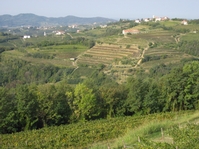 perched on slopes running up from the Adriatic Sea to the Giulian Alps, Collio is an envy-inducing place where half an hour in a car could place you either on a beach or on a ski slope. Seem like a tough choice? Well, it gets worse, because Collio itself is so appealing that it could tempt you to forsake both swimming and skiing and just stay put--to cycle through the gorgeous countryside or enjoy the sumptuous local cuisine and the dangerously delicious wines. perched on slopes running up from the Adriatic Sea to the Giulian Alps, Collio is an envy-inducing place where half an hour in a car could place you either on a beach or on a ski slope. Seem like a tough choice? Well, it gets worse, because Collio itself is so appealing that it could tempt you to forsake both swimming and skiing and just stay put--to cycle through the gorgeous countryside or enjoy the sumptuous local cuisine and the dangerously delicious wines.
I’m not sounding jaded any more, am I? So let me return to my opening theme for a moment, just to be clear. I’ve never lost sight of how fortunate I am to travel to experience wine regions, but really, it can get a little tiresome to go to places where the wines simply don’t live up to the hype used to sell them. For example, there are regions where the producers all have their story straight (“we make our wines in the vineyard and respect our distinctive terroir”), but the wines obviously belie the Party Line. When the character of the various wines shows no real continuity but only differences that clearly stem from winemaking techniques, it gets exasperating. And when some guy is telling me that he “makes his wines in the vineyard” at the very moment when he’s showing off his new French oak barriques, I stop taking notes and begin fantasizing about stabbing him with my pen.
Then there’s Collio. Rather like Alsace, most producers work with a fairly wide array of grape varieties that are mostly white. Unlike 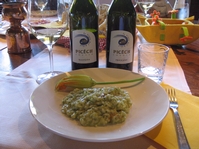 Alsace, where Riesling seems to be getting increasingly sweet and Pinot Gris is on the verge of becoming uselessly blowzy, almost all of Collio’s whites are finished dry. Alsace, where Riesling seems to be getting increasingly sweet and Pinot Gris is on the verge of becoming uselessly blowzy, almost all of Collio’s whites are finished dry.
But here’s what’s most impressive about the whites: On one hand, they show very sharply delineated varietal character, and even a novice taster could quickly identify whether he or she is tasting Pinot Grigio, Friulano, Sauvignon, Ribolla Gialla, Chardonnay or Pinot Bianco. But on the other hand, all the wines show a strong family resemblance to one another, a deeply etched terroir signature marking a Collio white as expressively aromatic, generously rich, crisply structured, and assertively mineral -- even to the point of seeming spicy.
These descriptors appear again and again in the tasting notes from my trip, but they only convey half of what is most exciting about these whites. Beyond their static elements is the dynamic interplay between ripe, broadly textured fruit and zesty, driving acidity.
This is not hyperbole. The whites are almost invariably refreshing, with lots of linear energy, and yet they routinely show so much breadth and richness that my traveling companions and I were continually checking labels to read alcohol levels. These were often pretty high, and yet very few of the wines showed any overt alcoholic heat in their aromas or finish. The ripeness of the wines was evident, but so too was a mineral undertone and an acidic balance that rendered it unproblematic.
Collio whites show an uncanny combination of warm climate ripeness with cold climate structure, and they show this combination across vintages, grape varieties, sub-districts, and producers. It is a very engaging profile, and it makes for wines that work very well at the table while also proving very enjoyable as sippers.
Clearly this profile is strongly influenced by the local climate, which in turn is influenced by regional geography. The tendency toward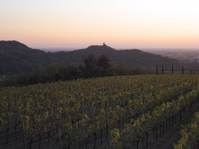 ripeness in the wines can be traced to warm currents from the sea as well as hillside exposures to the sun. By contrast, the crisp, structured aspect of the wines can be traced to the region’s exposure to cools winds from central Europe and Russia. These winds are moderated by the proximity of the Alps, which is very fortunate since there’s a fine line between harmful cold and helpful cool. ripeness in the wines can be traced to warm currents from the sea as well as hillside exposures to the sun. By contrast, the crisp, structured aspect of the wines can be traced to the region’s exposure to cools winds from central Europe and Russia. These winds are moderated by the proximity of the Alps, which is very fortunate since there’s a fine line between harmful cold and helpful cool.
Since Collio’s climate can fully ripen a range of white grapes, you might well be wondering about reds in the region, and here the good news continues. Although whites outnumber reds by about four to one, the reds are (not just “can be”) very good. Made mostly from Refosco, Cabernet Franc and Merlot, along with a little Pinot Nero and Cabernet Sauvignon and a few other bit players, they are balanced and restrained and mineral.
These descriptors might look like “damning with faint praise” to those who love whopping Zin and Shiraz wines, and that’s probably the correct reading for those with that sort of palate preference. However, those who love medium-weight red wines from places like Burgundy or the northern Rhône or Piedmont will likely love what they find from Collio, where reds are full of flavor without any extraneous weight or jammy ripeness.
It is important to emphasize that Collio’s reds are consistently ripe and convincing, unlike reds from other places that specialize in whites but also make reds. To be specific, red varieties are manifestly more at home in Collio than in Alsace or the Loire or Switzerland or Germany. All of those places make good red wines. Plus lots of thin, weedy ones--except in unusually warm years. All four of these places have climates that are generally quite marginal for red wine production.
The situation is subtly -- but importantly -- different in Collio. Its climate is also marginal for reds, but “marginal” means something different there, namely, highly suitable for certain varieties like Merlot and Cab Franc, though not for Grenache or Mourvedre. By contrast, almost all red varieties routinely struggle to achieve ripeness in Alsace, the Loire, Switzerland and Germany.
[If I were an economist, I’d drop a footnote at this point to identify an exception, even though it is an exception that proves my larger point. Collio has in fact turned out plenty of under-ripe, green, weedy reds that traveled under the name of Cabernet Franc. However, that’s solely because the plant material was mis-identified and was actually Carmenère. As a comparable case in Chile has proved, Carmenère is properly treated as a warm climate, very late-ripening variety, which is to say that it has no business being in Collio, where it literally stinks, by contrast to true Cabernet Franc, which performs beautifully there.]
Aside from red wines and single-variety whites, Collio produces several other notable wine types. Sparkling wines are made almost exclusively from Ribolla Gialla (which is suitable on account of its unusually high acidity), and they can be quite good. Naturally, since Chardonnay and Pinot Nero are also grown in the area, other producers are tempted to base sparklers on these, as in Champagne. Sweet wines are also produced fairly widely, and for these it is the Picolit grape that is most often utilized. Results can be very, very good -- if not quite at the world’s highest level for dessert wines.
Two remaining wine types that remain rather obscure in world markets are nevertheless potentially extraordinary, and truly merit the attention of connoisseurs in all quarters.
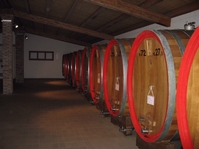 The more mainstream of these is Collio Bianco DOC, which is a highly variegated category of blended white wines. Although many producers base their Collio Bianco on local varieties, namely, Ribolla Gialla, Friulano and Malvasia, the DOC regulations permit French varieties as well, so it is never obvious what’s in a bottle bearing this designation. Nor is it apparent how the wine was made, as some producers vinify in neutral stainless steel, whereas others utilize new or new-ish barriques and still others use less assertive oak (meaning older barriques, 500 liter casks, or big ovals). The more mainstream of these is Collio Bianco DOC, which is a highly variegated category of blended white wines. Although many producers base their Collio Bianco on local varieties, namely, Ribolla Gialla, Friulano and Malvasia, the DOC regulations permit French varieties as well, so it is never obvious what’s in a bottle bearing this designation. Nor is it apparent how the wine was made, as some producers vinify in neutral stainless steel, whereas others utilize new or new-ish barriques and still others use less assertive oak (meaning older barriques, 500 liter casks, or big ovals).
The thread of continuity running through the various renderings of Collio Bianco is that producers seem to regard their particular 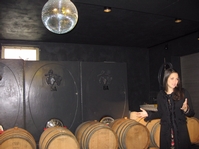 renditions as personal statements, with the consequence that they vector much of their attention and a lot of their best fruit toward these wines. Of course, no Collio Bianco blend can embody one of the most exciting attributes of the region’s whites, which is the capacity for showing vivid varietal character while also displaying a deep regional terroir stamp. Nevertheless, I walked out of more than one cellar believing that the best of all the wines was the producers’ Collio Bianco, and I’ll be watching like a hawk for these in coming years. renditions as personal statements, with the consequence that they vector much of their attention and a lot of their best fruit toward these wines. Of course, no Collio Bianco blend can embody one of the most exciting attributes of the region’s whites, which is the capacity for showing vivid varietal character while also displaying a deep regional terroir stamp. Nevertheless, I walked out of more than one cellar believing that the best of all the wines was the producers’ Collio Bianco, and I’ll be watching like a hawk for these in coming years.
A remarkable last category for consideration is the so-called “Orange Wines” made from Ribolla Gialla in and around the commune of Oslavia. Although local producers aspire to a DOCG classification for Ribolla di Oslavia, there’s not yet any official designation for these outlandish wines, which are currently labeled Collio DOC with the variety identified or, in some cases, Venezia Giulia IGT. Ribolla Gialla is the grape behind the entire category, and the fruit is typically left on the vine for as long as possible and then macerated for a very long time as if it were red wine that was being made.
Macerations may continue for one to nearly four months (!), with some producers then pressing the grapes and returning them to big old casks for years before they are readied for sale. Striking in appearance, they range from golden to copper to amber to screaming orange, which seems an impossible outcome for a white grape, though producers attribute this to the effects of extreme hang time on vines as well as extended skin contact. Big and assertive but not sweet, they can display explosive aromatics and amazing tannic grip, but in the best renditions this muscularity coincides with surprising intricacy and freshness, with remarkable notes of apricots, mandarin oranges, and preserved lemons.
There’s something of a Wonderland aspect to Oslavia in particular and Collio in general, but traveling in the area also entails some back-to- reality sights such as the immense, somewhat ghostly, intensely moving memorial above the burial ground for more than 57,000 who died here in a horrible series of battles along a stationary front during World War I. The town of Oslavia was utterly destroyed down to the last home, with just one wall still standing in the aftermath and the entire hill on which Oslavia was built reduced by more than 12 feet in altitude due to shelling. reality sights such as the immense, somewhat ghostly, intensely moving memorial above the burial ground for more than 57,000 who died here in a horrible series of battles along a stationary front during World War I. The town of Oslavia was utterly destroyed down to the last home, with just one wall still standing in the aftermath and the entire hill on which Oslavia was built reduced by more than 12 feet in altitude due to shelling.
I make mention of this just to balance out the portrait of this place, which has its horrors and challenges like almost anywhere else in Europe. But situated as it is within a short drive from Venice, Collio holds huge potential for growth as a travel destination, and many of the producers I visited have recently built inviting guest rooms. 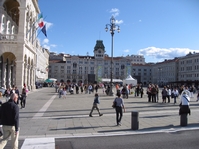 Quick side trips into the lovely city of Trieste or up into the Alps or into Slovenia or down the nearby (famously beautiful) coast of Croatia combine to make Collio a place with almost countless attractions--and one that I’ll return to at my first opportunity. Quick side trips into the lovely city of Trieste or up into the Alps or into Slovenia or down the nearby (famously beautiful) coast of Croatia combine to make Collio a place with almost countless attractions--and one that I’ll return to at my first opportunity.
For now though, like most of you, I’ll need to content myself with tasting the region’s wines. I have full tasting notes for everything included below, and will likely publish full reviews for most wines that are reasonably widely imported into the USA. Yet it seems wise to recognize all of the very best wines that I tasted to enhance your chances of finding a few to try now. Although I’ve never had an opportunity to taste Collio wines in vast numbers until this recent trip, I’ve enjoyed them for years and found excellent examples without difficulty. You’ll probably need to do a little leg work to find some in your area, but your efforts will be rewarded in spades.
Friulano: Ronco Blanchis 2010 (91); Venica & Venica 2010 (91); Villa Russiz 2010 (91); Gradis’Ciutta 2010 (90); Marco Felluga 2010 (89); Picéch 2010 (89).
Malvasia: Venica & Venica 2010 (92); Picéch 2010 (90).
Ribolla Gialla: Gradis’Ciutta 2010 (90).
Collio Bianco: Ronco Blanchis 2010 (92); Russiz Superiore “Col Disore” 2008 (92); Marco Felluga “Molamatta” 2009 (91); Picéch “Jelka” 2008 (91); Livon “Solarco” 2010 (90); Gradis’Ciutta “Bratinis” 2009 (90); Zuani 2010 (90); Angoris 2010 (89).
Pinot Grigio: Marco Felluga Riserva “Mongris” 2007 (91); Villa Russiz 2010 (91); Ronco Blanchis 2010 (90); Venica & Venica 2010 (90); Angoris 2010 (89); Gradis’Ciutta 2010 (89).
Sauvignon: Venica & Venica “Ronca delle Mele” 2010 (92); Villa Russiz “de la Tour” 2010 (92); Villa Russiz “de la Tour” 2009 (92); Russiz Superiore Riserva 2006 (92); Ronco Blanchis 2010 (91); Russiz Superiore 2010 (90).
Pinot Bianco: Venica & Venica 2010 (92).
Chardonnay: Ronco Blanchis 2004 (94); Marco Felluga 2009 (90).
Venezia Giulia IGT: Livon “Braide Alte” 2009 (92).
“Orange Wines”: Dario Prinčič, Venezia Giulia IGT 2007 (93); Radikon, Venezia Giulia IGT Ribolla Gialla 2005 (92, 500 ml); La Castellada Collio 2006 (90); Il Carpino, Venezia Giulia IGT 2008 (90); Primosic, Collio 2008 (90); Fiegl, Collio Ribolla Gialla 2010 (89).
Red Wines: Russiz Superiore Riserva “Degli Orzoni” 2006 (94); Russiz Superiore Cabernet Franc 2009 (91); Villa Russiz Merlot 2009 (90); Livon Refosco “Riul” Collio Orientali del Friuli 2007 (89).
* * *
Questions or comments? Write to me at mfranz@winereviewonline.com
|
 |
|